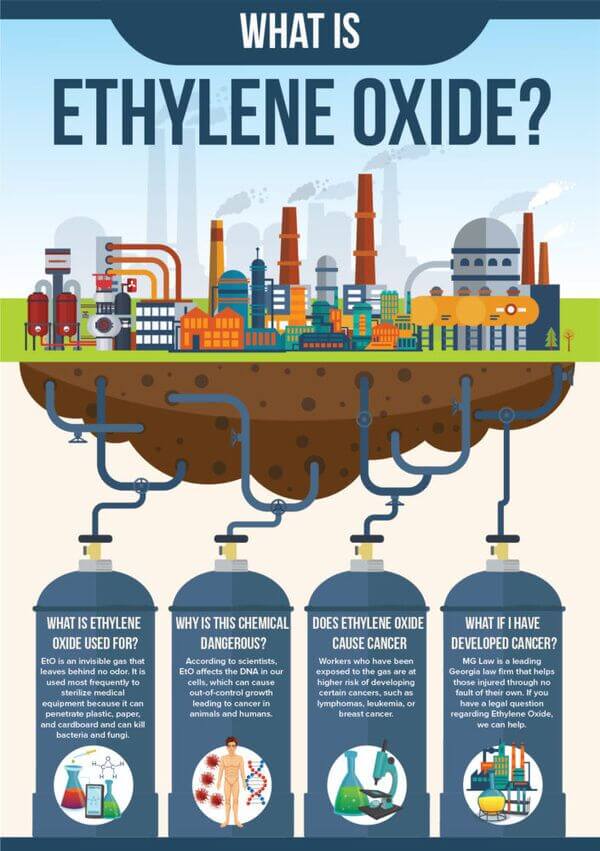What is ethylene oxide, Georgia residents ask? Ethylene oxide has been in the news lately. But what exactly is it? And should members of the public be worried? The federal government has not done a good job of releasing helpful information to the public, so we feel the need to step into the gap.
On July 19, 2019, WebMD published an article on ethylene oxide and cancer, which contained eye-opening information about this chemical and the increased risk of cancer in our communities.
It turns out that our communities have been exposed to very high levels of ethylene oxide for decades, and many of our residents are becoming sick.
Learn how our experienced Georgia ethylene oxide exposure lawyers can assist you. Call (770) 988-5252 or reach us online for a free consultation.

What is Ethylene Oxide Used For?
Ethylene oxide, also known as EtO, is an invisible gas that leaves behind no odor. This chemical has many uses, such as being a component of antifreeze. But the chemical is used most frequently to sterilize medical equipment because it can penetrate plastic, paper, and cardboard and can kill bacteria and fungi.
BD Bard, a large company in Covington that sterilizes medical equipment, uses ethylene oxide. It is also used by other companies in the state.
Does Covington Have High Emissions of Ethylene Oxide?
Yes. BD Bard has released the chemical continuously into the air for decades. In 1987, it released 76,000 pounds of EtO. This load dropped to 35,700 pounds in 1991 and has declined since.
The federal government has identified Covington as one of the census tracts in the U.S. with high cancer risks because of airborne toxins like ethylene oxide. Covington was only one of three tracts in the state with this designation. The other two were in the Smyrna area, where a Sterigenics medical sterilization plant operates.
Why Is this Chemical Dangerous?
According to scientists, EtO affects the DNA in our cells, which can cause out-of-control growth. This leads to cancer in animals and humans. Because the gas is odorless, you might have no idea you are breathing it in.
Alarmingly, the industry has been aware for decades that Eto is dangerous. In fact, one company reported it as a problem chemical all the way back in 1981, well before the gas was on the government’s radar as potentially dangerous.
Does Ethylene Oxide Cause Cancer?
Yes, it does. Workers who have been exposed to the gas are at higher risk of developing certain cancers, such as lymphomas, leukemia, or breast cancer. A study in 2004 confirmed that exposure increased the risk of developing these diseases. In 2016, the Environmental Protection Agency identified the chemical as one that “definitely” causes cancer.
When mice were exposed to EtO, they developed brain, lung, and uterine cancers. They also developed other cancers in connective tissue.
The real controversy is the extent to which airborne emissions can cause cancer in the public. Ethylene oxide does not last forever. It has a half-life of around 7 months. That means that in seven months the chemical will break down 50%. Ethylene oxide can also be dispersed by wind, so members of the public have been less exposed to it than those who work directly with the gas.
However, according to the Environmental Protection Agency, this chemical has caused an additional 214 cases of cancer per 1 million people in Covington. Any chemical that causes over 100 cancers per 1 million people creates an unacceptable risk, so EtO gas is very dangerous.
Why Am I Just Now Hearing about This?
This is a great question. WebMD and Georgia Health News were the first to break this information to the public, even after the federal government collected information about the cancer risk caused by ethylene oxide.
Unfortunately, many people are unaware that their cancer might have been caused by gasses released by BD Bard.
How Do We Know How Much Bard Is Emitting?
The company has installed equipment which destroys 99.95% of emissions, however all measurements of emissions are based on self reporting. No government, private or independent group has ever tested or verified Bard’s estimation of emission levels. This is higher than the government’s mandate that 99% of emissions be destroyed. However, some people believe that the amount of ethylene oxide is still too high in Covington and nearby areas. Nevertheless, the state has not yet required the company to take additional safety precautions.
What Are the Updated Environmental Protection Agency Regulations Concerning Ethylene Oxide?
In March 2024, the Environmental Protection Agency (EPA) finalized updated regulations for certain commercial sterilization facilities that emit ethylene oxide. To develop these regulations, the EPA conducted outreach to communities and stakeholders to encourage participation in the public comment process. It held public hearings, webinars, and meetings hosted by its regional offices. The EPA received significant input from communities and industry stakeholders.
Reduced Emissions
Under the new EPA rule, all commercial sterilization facilities must reduce EtO emissions by installing new control technologies. According to the EPA, these technologies will reduce EtO emissions by approximately 90% nationwide once fully implemented. Reducing the emissions will also decrease lifetime cancer risks for people living near commercial sterilization facilities across the country.
The new EPA rule finalized amendments to the National Emission Standards for Hazardous Air Pollutants (NESHAP) that:
- Establish standards for unregulated emissions, such as building leaks and chamber exhaust vents;
- Strengthen existing standards for sources of emissions, such as sterilization chamber vents and aeration room vents;
- Require continuous monitoring and quarterly reporting for commercial sterilization facilities;
- Subject sterilization facilities to emission standards during periods of startup, shutdown, and malfunction to ensure continuous clean air protection; and
- Clarify electronic reporting and technical revisions.
The EPA estimates these new regulations will reduce EtO emissions by approximately 21 tons per year.
Ethylene oxide sterilization facilities must adopt these new regulations over the next two to three years. The estimated capital costs for the final rule are approximately $313 million.
What Facilities Are Impacted?
The new EPA rule is expected to affect nearly 90 commercial sterilization facilities that are owned and operated by approximately 50 companies (including Sterigenics and BD Bard in Georgia).
Remaining Concerns
While the amendments are beneficial for public health, a few concerns remain. For local communities, the timeline seems delayed. Two to three years of continued exposure to these toxins can lead to new cases of cancer and illness. In some cases, it could take longer than three years to implement changes because facilities can apply for a one-year extension.
Additionally, the Clean Air Act has provisions that allow the U.S. President to grant two-year compliance exemptions to facilities that need additional time to adopt required technologies in particular circumstances. The medical device industry pushed the EPA to elongate the compliance timelines because having to implement the regulations would disrupt the medical device supply chain.
The current Administration has informed the EPA that it will exercise this backstop authority to protect the medical supply chain if necessary. While the medical device industry is critical to many aspects of our public health system, moving compliance timelines further out may lead to increased cancer cases.
Additional EPA Actions
The EPA is concerned that chemical plants are emitting ethylene oxide. The EPA is therefore strengthening standards to reduce EtO and other hazardous pollutants from chemical plants.
To address EtO emissions and advance research, the EPA is investigating additional sources of EtO and opportunities for emissions controls. The EPA also continues to enforce existing regulations and is conducting further research to better measure EtO.
What if I Have Developed Cancer?
Cancer has many causes, some of which are genetic. But some cancers are more common after exposure to ethylene oxide. If you have lived in this community for years and developed cancer, we understand that pointing a finger at ethylene oxide makes sense.
Contact an Experienced Ethylene Oxide Exposure Attorney in Georgia
MG Law is a leading Georgia law firm that helps those injured through no fault of their own. If you have a legal question, we can help. Please contact our Georgia ethylene oxide exposure lawyers today for a free consultation.
Get started by calling (770) 988-5252 or filling out our online form.

